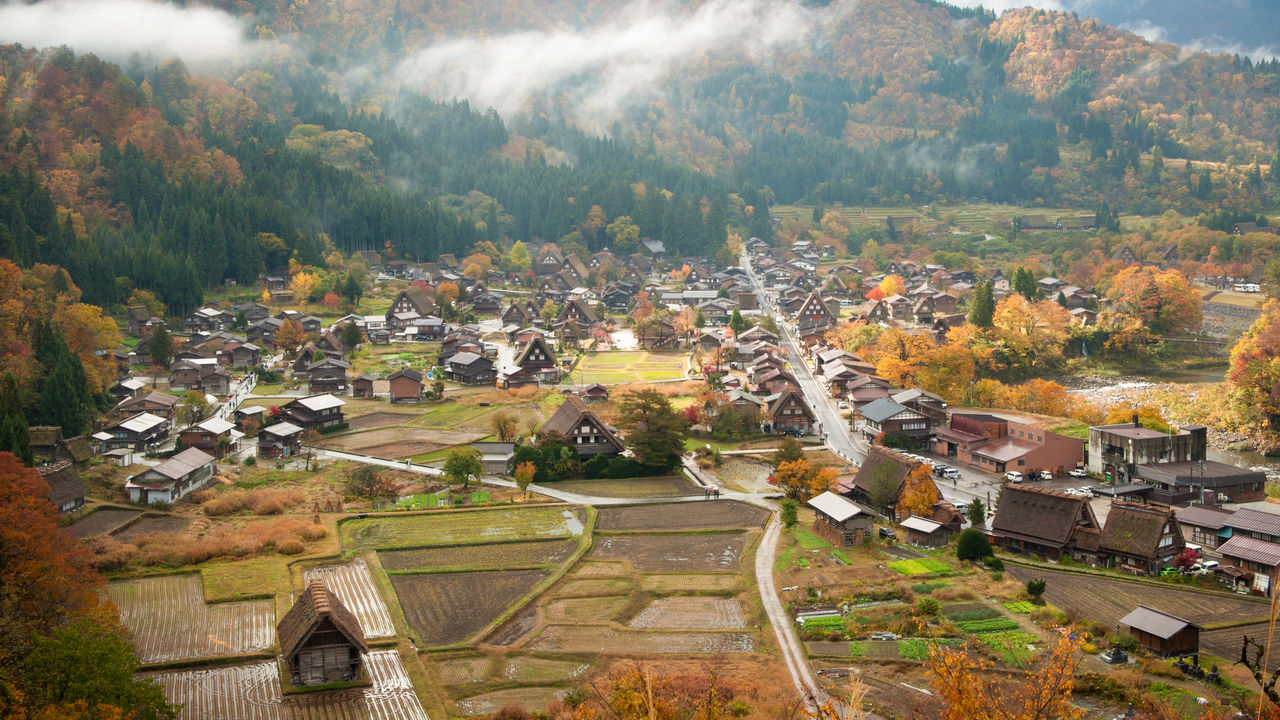
The Magnificent Mountains of Autumn: Japan’s World Heritage Villages Keep the Old Ways Alive
Guideto Japan
- English
- 日本語
- 简体字
- 繁體字
- Français
- Español
- العربية
- Русский
Ancient Landscapes in Autumn Reds and Golds
With their thatched roofs under heavy snow, Shirakawa-gō in northwest Gifu Prefecture and nearby Gokayama in southwest Toyama Prefecture, both located in the Shō River catchment area, are famed as traditional winter vistas that still survive today. But the rich tapestry of fall foliage that surrounds them before the snows fall makes for beautiful views that are well worth a trip to see.
Related article › World Heritage Site Shirakawa-gō (360°/Gigapixel)
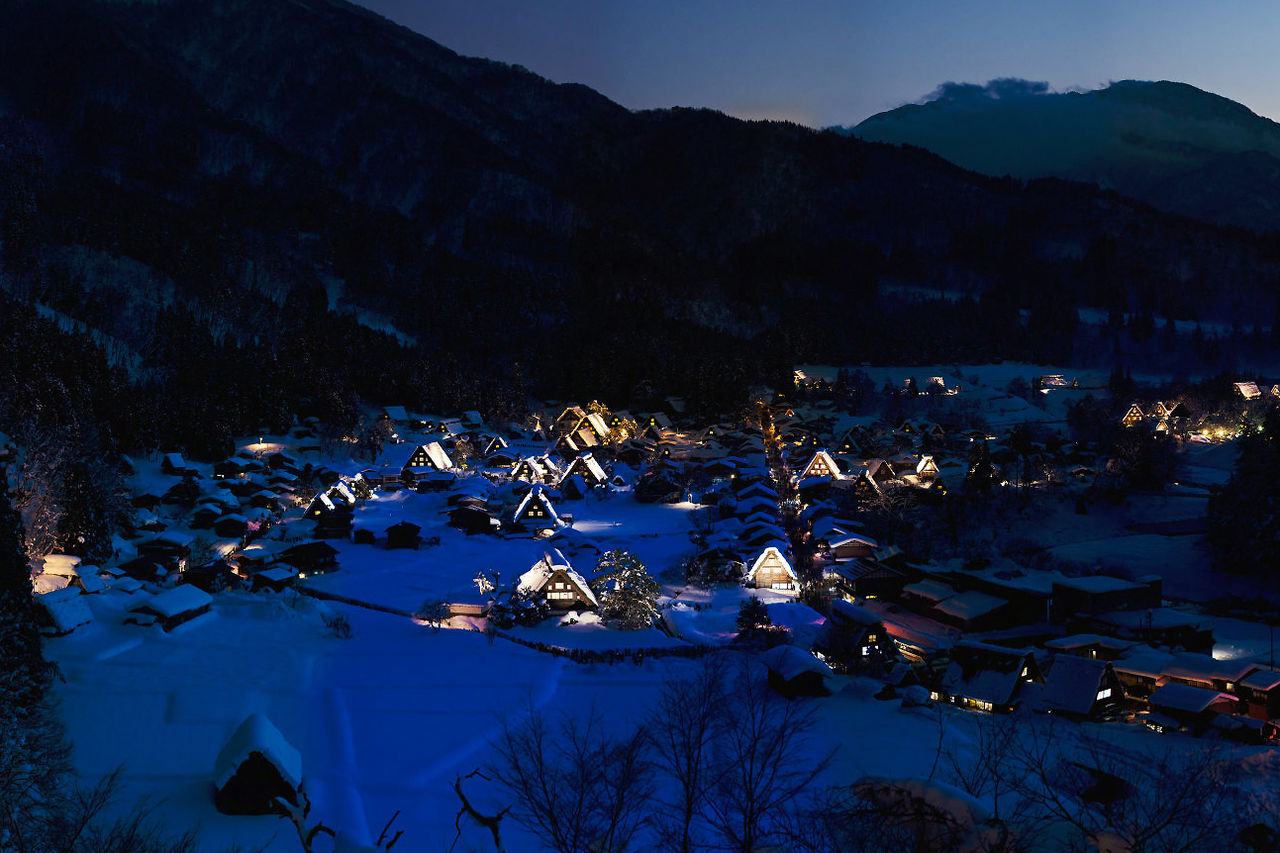 Shirakawa-gō lit up in the depths of winter. (© Somese Naoto)
Shirakawa-gō lit up in the depths of winter. (© Somese Naoto)
What makes these villages unique is their gasshō-zukuri architecture: thatched roofs that rise steeply to a central peak, like two hands together in prayer (a gesture known as gasshō in Japanese). These roofs seem to have been developed against the heavy snows that fall between the mountains in this high-humidity region, but one side effect was the spacious attics beneath. The gables are so wide that windows for air circulation can be set into them with ease, creating an ideal space for raising silkworms. For a community surrounded by steep slopes, with limited level ground to grow crops, architecture that both protects the house from the snow and makes room for another way of earning income is a two-birds, one-stone solution.
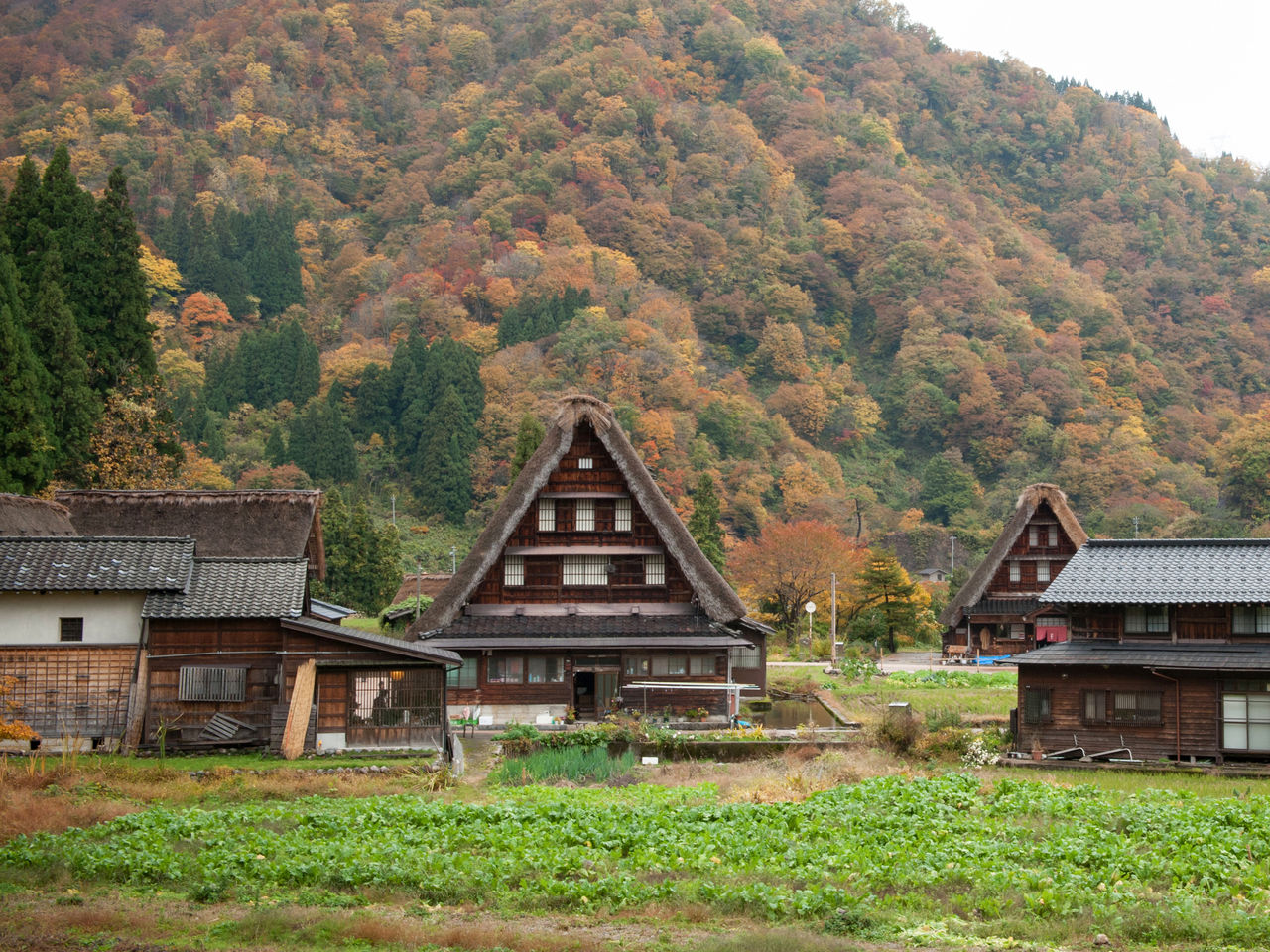 Gasshō-zukuri houses in Gokayama. The windows set into the broad gables create a better environment for the silkworms in the attic.
Gasshō-zukuri houses in Gokayama. The windows set into the broad gables create a better environment for the silkworms in the attic.
Through community efforts, the traditional structures of Shirakawa-gō and Gokayama were preserved even through Japan’s dramatic postwar transformation, allowing visitors today to catch a glimpse of the traditional culture and way of life that thrived in Japan’s mountain valleys in centuries past. In 1995, the “Historic Villages of Shirakawa-gō and Gokayama” were inscribed on the UNESCO World Heritage List, and today they are fully equipped for tourists and sightseers, with one survey in Shirakawa-gō recording 1.76 million visitors in 2017. Some 650,000 of these were from outside Japan, representing a 9% increase in foreign tourism from the previous year.
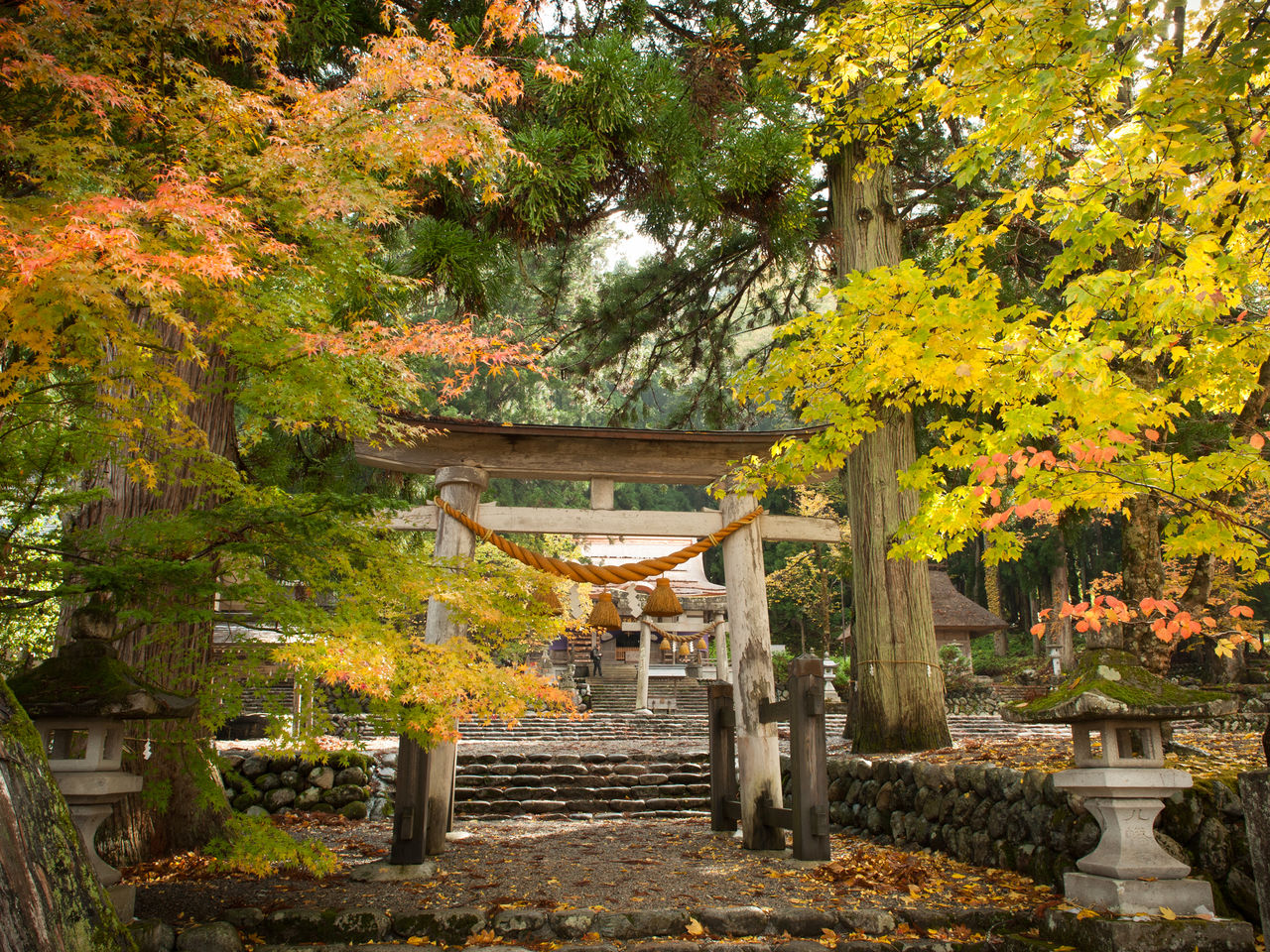 Gold and crimson surrounds Shirakawa Hachiman Shrine, where the ujigami (guardian spirit) of the area is worshipped.
Gold and crimson surrounds Shirakawa Hachiman Shrine, where the ujigami (guardian spirit) of the area is worshipped.
The Rooftops of Shirakawa-gō in Autumn
The heart of Shirakawa-gō is Ogimachi, where the leaves begin to turn in the middle of October. The autumn colors seem to flow down from the mountains, with the first reds and golds appearing near the peak and then gradually descending and spreading out. This makes the best time to see the autumn sights late October through early- to mid-November.
A fine view of the area can be enjoyed from the observation deck at the Shiroyama Tenshukaku restaurant, or the Ogimachi observation deck. Shiroyama Tenshukaku is accessible by car, but the roads are so narrow that the shuttle bus is more convenient. On foot, it is about 20 minutes from the Shirakawa-gō central bus terminal. Riding the bus there and then enjoying a leisurely walk back is the best of both worlds.
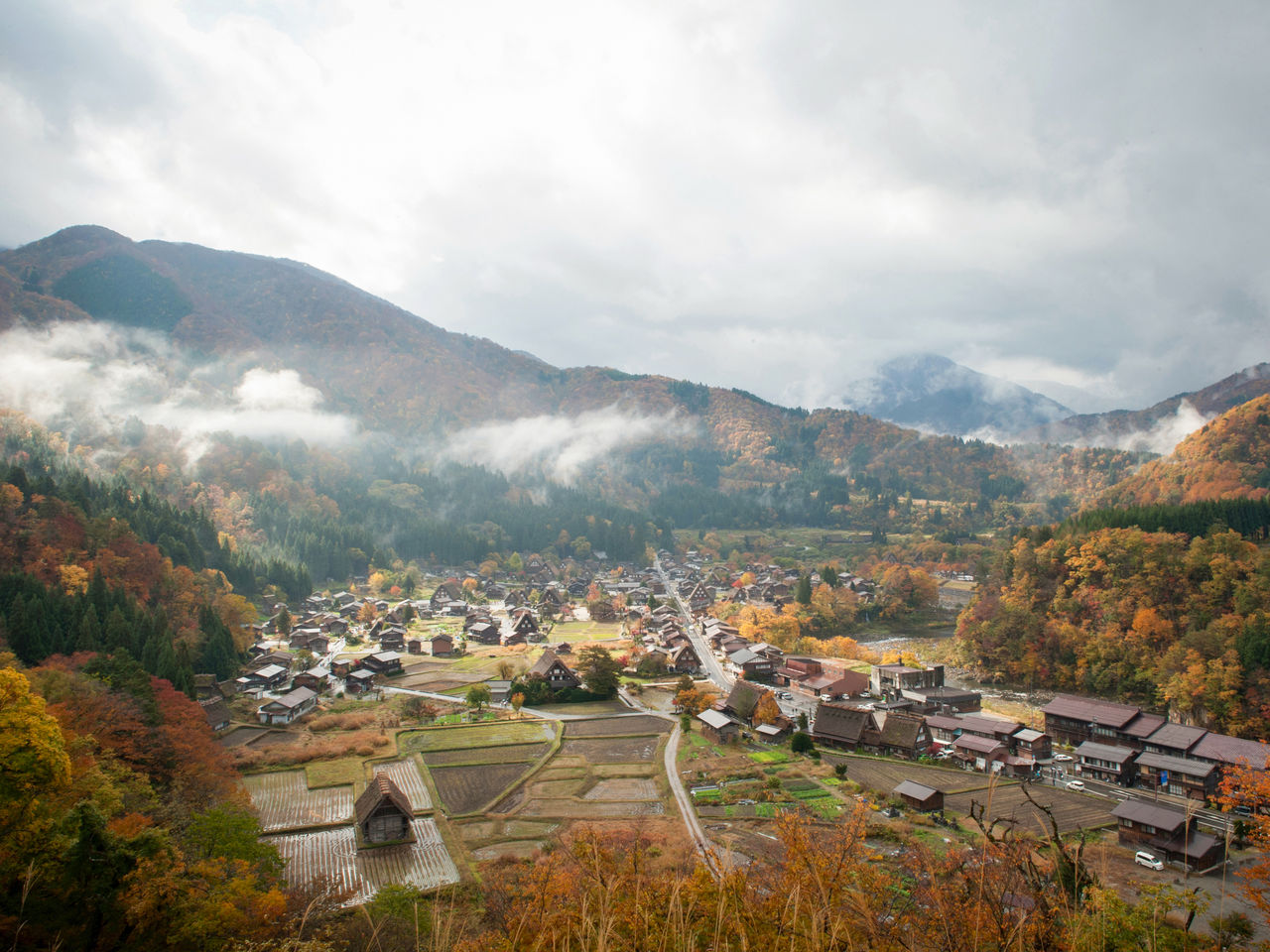 The Ogimachi hamlet in its autumn finery, viewed from the Tenshukaku observation deck.
The Ogimachi hamlet in its autumn finery, viewed from the Tenshukaku observation deck.
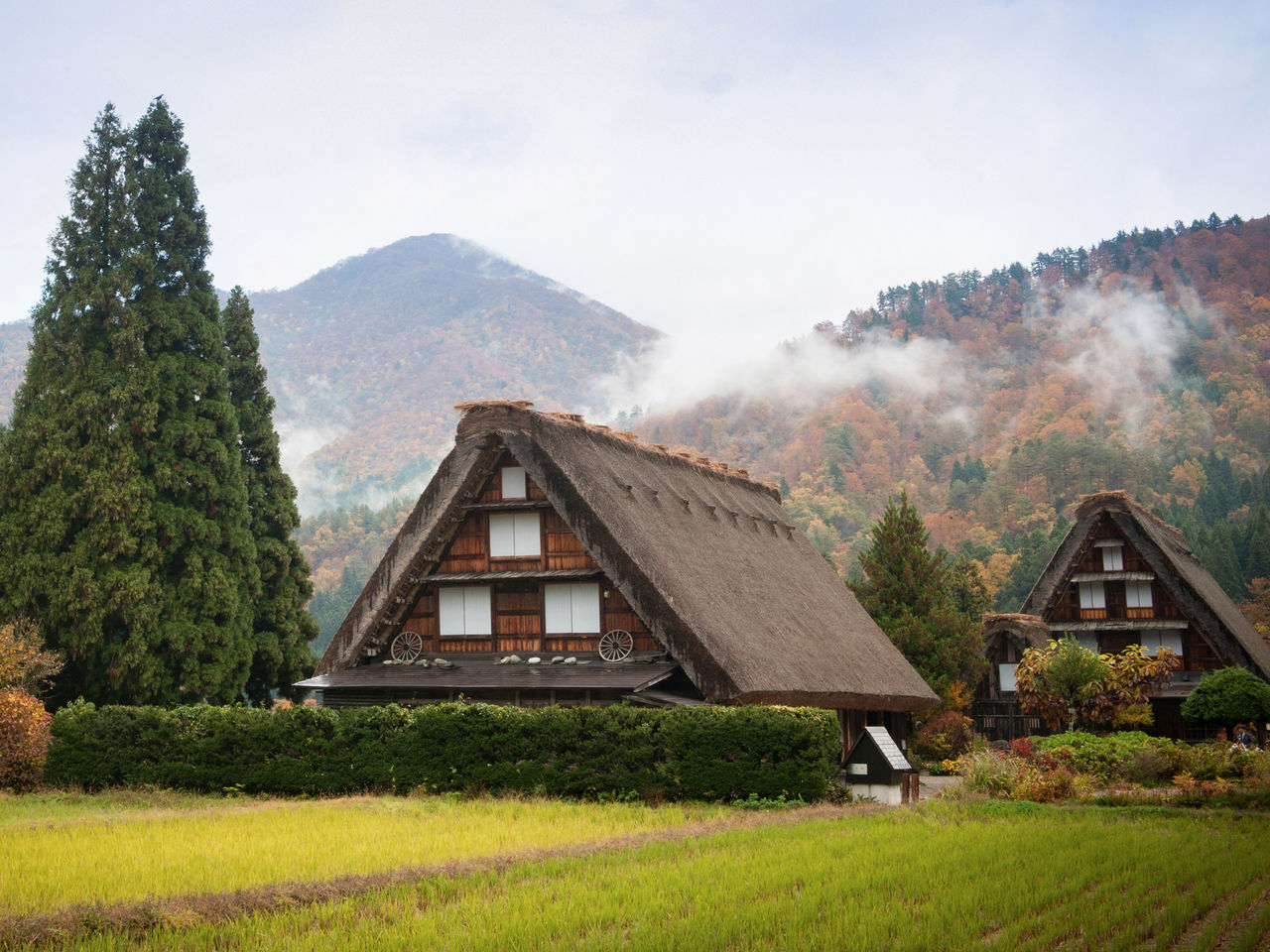 A gasshō-zukuri house. The blazing autumn mountains in the background add to the picturesque atmosphere.
A gasshō-zukuri house. The blazing autumn mountains in the background add to the picturesque atmosphere.
Three hours is plenty of time to enjoy the traditional streetscapes of Ogimachi. Some buildings are open to the public so that visitors can see what gasshō-zukuri houses were like inside, while others today house restaurants, accommodation, and souvenir stores, making for interesting discoveries all over the area.
The biggest event in autumn is the issei hōsui in early November, when the village tests its sprinkler system as practice for winter, when fires are most likely to break out. The sight of a rural village in autumn colors surrounded by a curtain of water is remarkable.
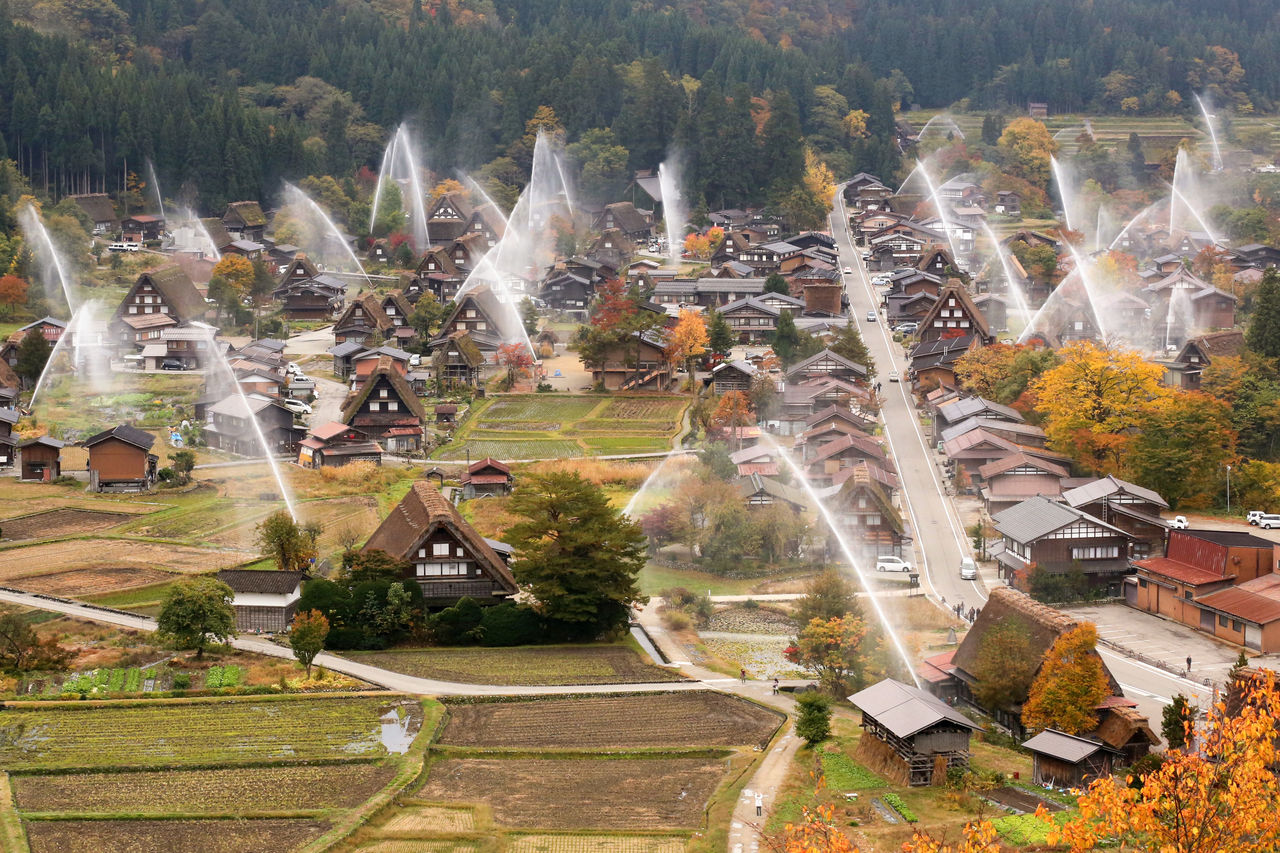 The issei hōsui is a magnificent sight with a purpose—keeping the community prepared to fight fires that would be disastrous for its thatched roofs. (© Jiji Photo)
The issei hōsui is a magnificent sight with a purpose—keeping the community prepared to fight fires that would be disastrous for its thatched roofs. (© Jiji Photo)
There are also seasonal illumination displays at the gasshō-zukuri houses in the open-air museum, a collection of 25 old farmhouses open to public exploration.
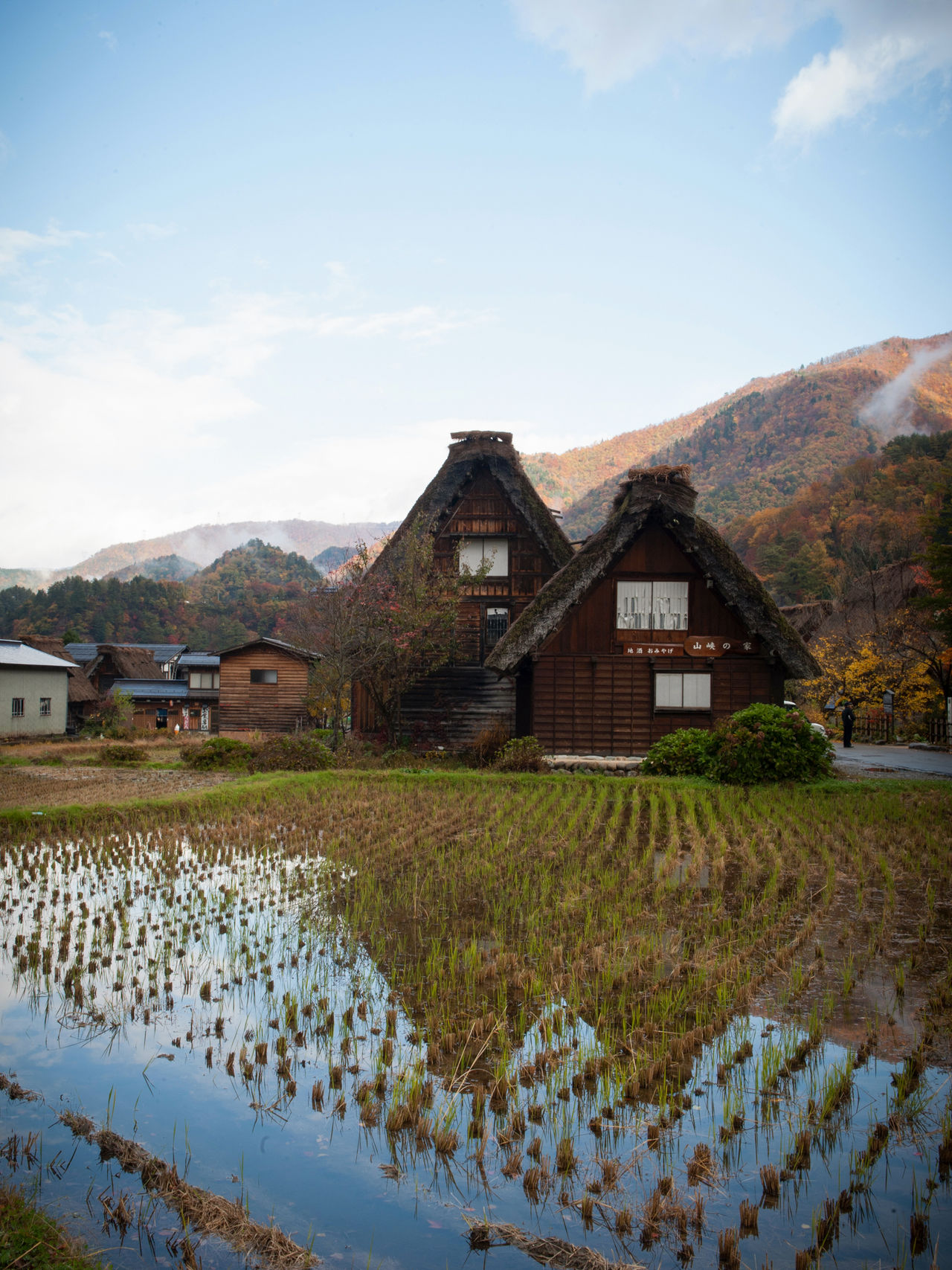 These traditional buildings are now home to stores offering local sake and souvenirs.
These traditional buildings are now home to stores offering local sake and souvenirs.
Getting to Shirakawa-gō
- From Nagoya Station: 2 hr 50 min by Gifu Bus on the Kōsoku Shirakawa-gō route
- From Kanazawa Station: 1 hr 15 min by Hokuriku Railroad Nōhi Bus on the Shirakawa-gō/Kanazawa route
- From Toyama Station: 1 hr 25 min by Toyama Chihō Railway Nōhi Bus on the Takayama route
- From Takaoka Station: 2 hr 10 min by Kaetsunō Bus on the World Heritage route
Idyllic Mountain Valleys in Gokayama
Gokayama is a collective term for five valleys along the Shō River: Akao, Kaminashi, Shimonashi, Otani, and Toga. The area includes two villages inscribed on the World Heritage List: Suganuma, near the first Gokayama interchange north of the Shirakawa-gō interchange on the Tōkai-Hokuriku Expressway, and Ainokura, about 15 minutes’ drive northeast of that along National Highway 156.
The autumn colors arrive in Gokayama at around the same time as in Shirakawa-gō. Walking through these gasshō-zukuri villages, with brightly colored mountains as a backdrop, presents visitors with evocative details like persimmons hanging from the eaves to dry, evoking timeless rural lifestyles.
 Autumn leaves adorn the peaceful thatched village of Suganuma.
Autumn leaves adorn the peaceful thatched village of Suganuma.
Suganuma consists of just nine thatched houses, spaced far enough apart to create a peaceful, rural atmosphere. The snow is even heavier in Gokayama than in Shirakawa-gō, which is said to be why the gasshō-zukuri roofs are even steeper.
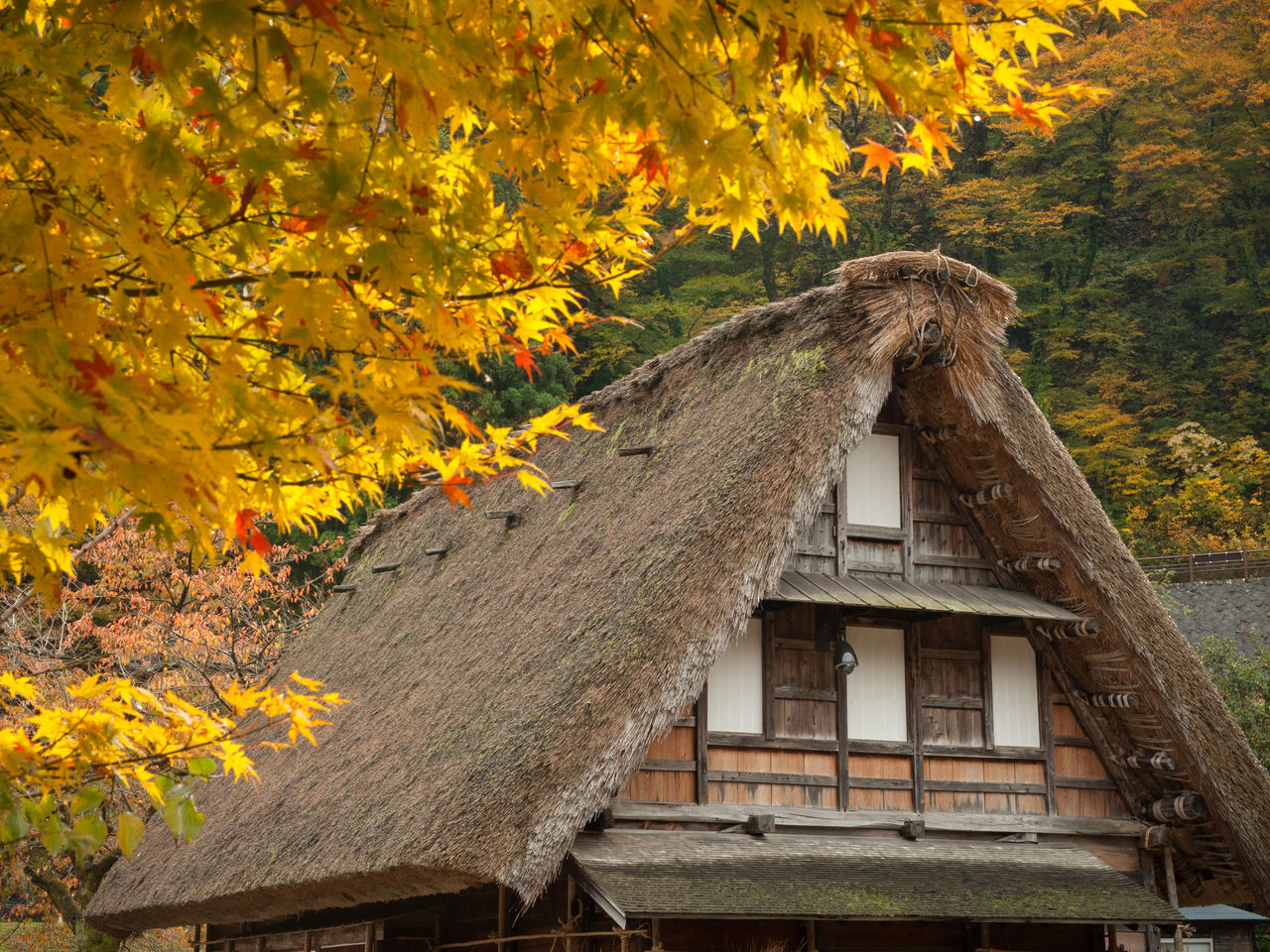 The gold of the autumn foliage is all the more brilliant against the faded brown of this Suganuma thatched roof.
The gold of the autumn foliage is all the more brilliant against the faded brown of this Suganuma thatched roof.
Ainokura is home to 23 gasshō-zukuri houses, most still home to local residents and families. The observation deck a 5-minute walk uphill from the parking lot affords a marvelous view of the village, especially when it is nestled among hillsides of deep fall orange.
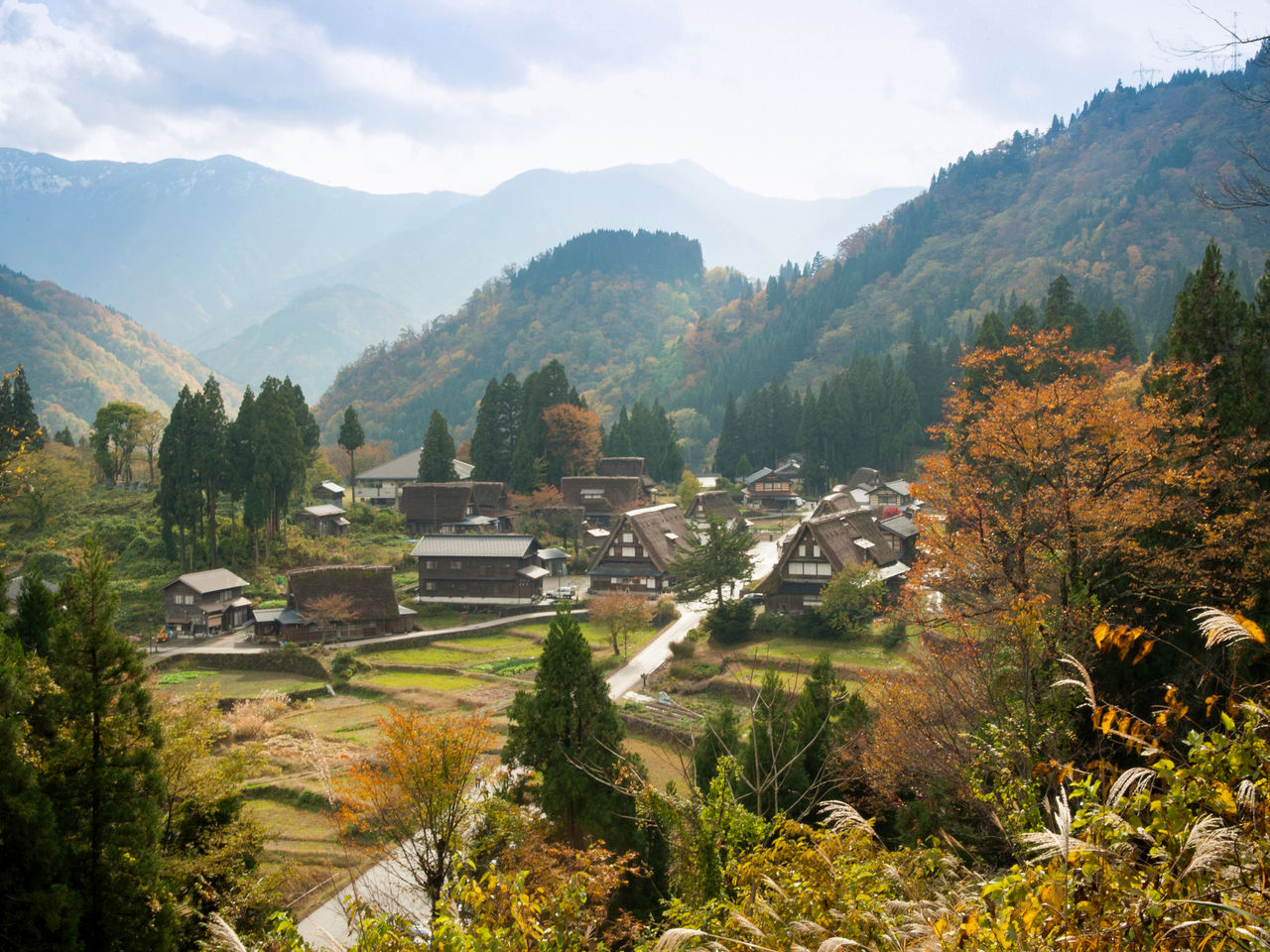 One striking feature of Ainokura is the single straight road that goes right through town.
One striking feature of Ainokura is the single straight road that goes right through town.
Gokayama is home to many designated Important Cultural Properties, including the Iwase and Murakami residences, as well as tourist attractions like the Kuroba Hot Springs and the Min’yō no Sato (“Village of Folk Song”) park.
Being a Good Guest
As these areas are still real residential areas home to regular people, sightseers and tourists are asked to be considerate when they visit. Some important guidelines include:
- There are few garbage cans in the area, so plan to take any trash home.
- Gasshō-zukuri houses are very vulnerable to fire, so smoking is strictly forbidden anywhere outside the designated areas.
- Do not enter private property or try to look into private homes.
- To preserve the character of the area, there are no guard rails by the roads or fences along the rivers, so take care and stay safe while navigating the community’s lanes.
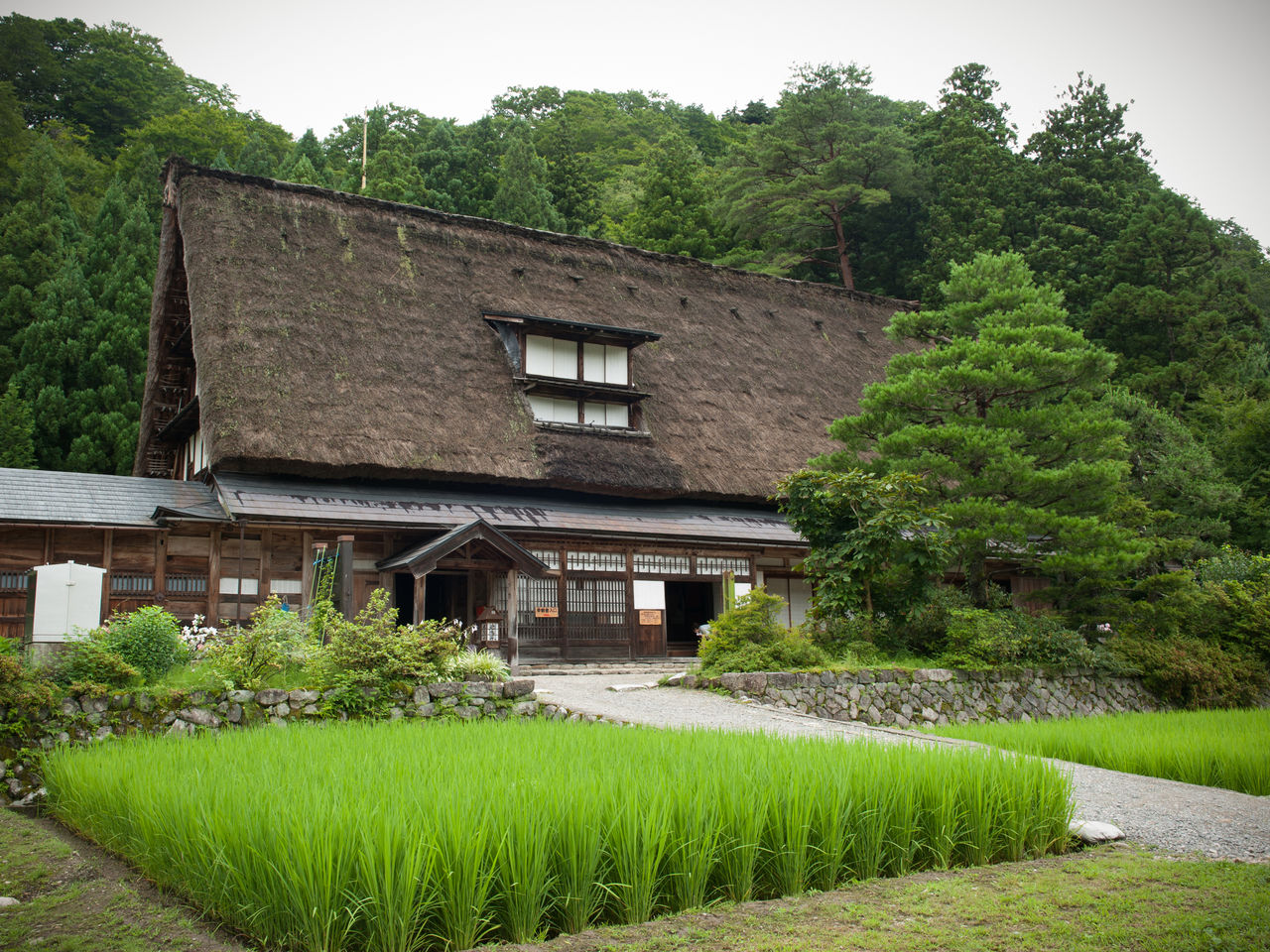 At five stories, the Iwase Residence is the largest gasshō-zukuri house in either Shirakawa-gō or Gokayama. (Photograph taken in July)
At five stories, the Iwase Residence is the largest gasshō-zukuri house in either Shirakawa-gō or Gokayama. (Photograph taken in July)
Getting to Gokayama
- From Nagoya Station: Around 2 hr 30 min on the Dolphin Traffic Kito Kito Liner
- From Kanazawa Station: Around 1 hr by Hokuriku Highway Express Bus on the Takayama route
- From Toyama Station: Around 20 min to Takaoka Station on the Ainokaze Toyama Railway, then around 1 hr 20 min by World Heritage Bus to the Ainokuraguchi bus stop
- From Ainokura to Suganuma: Around 15 min on the World Heritage Bus from the Ainokuraguchi to the Suganuma stop
- From Suganuma to Shirakawa-gō: Around 40 min on the World Heritage Bus from the Suganuma to the Shirakawa-gō (Ogimachi) stop
(Originally written in Japanese. Reporting, writing, and photography by Kuroiwa Masakazu, except where otherwise noted. Banner image: Shirakawa-gō in autumn, viewed from the Tenshukaku observation deck.)
Shirakawa-gō Toyama tourism World Heritage autumn foliage Hokuriku mountains Gokayama